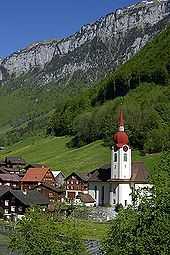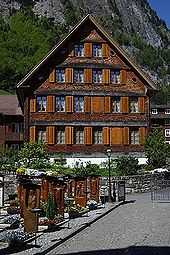Isenthal
| Isenthal | ||||||||||
|---|---|---|---|---|---|---|---|---|---|---|
 | ||||||||||
| ||||||||||
| Population | 529 (Dec 2012)[1] | |||||||||
| - Density | 9 /km2 (23 /sq mi) | |||||||||
| Area | 60.99 km2 (23.55 sq mi)[2] | |||||||||
| Elevation | 771 m (2,530 ft) | |||||||||
| Postal code | 6461 | |||||||||
| SFOS number | 1211 | |||||||||
| Surrounded by | Attinghausen, Bauen, Beckenried (NW), Emmetten (NW), Engelberg (OW), Flüelen, Seedorf, Seelisberg, Wolfenschiessen (NW) | |||||||||
| Website | www.isenthal.ch SFSO statistics | |||||||||
 Isenthal | ||||||||||
| Location of Isenthal
 | ||||||||||
Isenthal is a municipality in the canton of Uri in Switzerland.
History
Isenthal is first mentioned in 1280 as Yseltal.[3]
Geography


Isenthal has an area, as of 2006, of 61 km2 (24 sq mi). Of this area, 27.9% is used for agricultural purposes, while 26.2% is forested. Of the rest of the land, 0.6% is settled (buildings or roads) and the remainder (45.3%) is non-productive (rivers, glaciers or mountains).[4] In the 1993 land survey, 21.4% of the total land area was heavily forested, while 1.4% is covered in small trees and shrubbery. Of the agricultural land, 0.0% is used for farming or pastures, while 5.7% is used for orchards or vine crops and 22.2% is used for alpine pastures. Of the settled areas, 0.3% is covered with buildings, and 0.2% is transportation infrastructure. Of the unproductive areas, 0.9% is unproductive flowing water (rivers), 35.6% is too rocky for vegatation, and 8.8% is other unproductive land.[5]
The municipality is located at the intersection of the Sernftal and the Grosstal. It consists of the village of Isenthal and widely scattered small settlements.
Demographics
Isenthal has a population (as of 31 December 2012) of 529.[1] As of 2007, 0.2% of the population was made up of foreign nationals. Over the last 10 years the population has decreased at a rate of -6.8%. Most of the population (as of 2000) speaks German (99.3%), with Polish being second most common ( 0.4%) and French being third ( 0.2%).[4] As of 2007 the gender distribution of the population was 52.4% male and 47.6% female.[6]
In the 2007 federal election the FDP party received 92.3% of the vote.[4]
The entire Swiss population is generally well educated. In Isenthal about 60.5% of the population (between age 25-64) have completed either non-mandatory upper secondary education or additional higher education (either university or a Fachhochschule).[4]
Isenthal has an unemployment rate of 0.17%. As of 2005, there were 116 people employed in the primary economic sector and about 47 businesses involved in this sector. 22 people are employed in the secondary sector and there are 6 businesses in this sector. 71 people are employed in the tertiary sector, with 17 businesses in this sector.[4]
The historical population is given in the following table:[3][7]
| year | population |
|---|---|
| 1698 | c. 150 |
| 1743 | 176 |
| 1799 | 360 |
| 1850 | 502 |
| 1900 | 595 |
| 1950 | 550 |
| 1970 | 570 |
| 1980 | 535 |
| 1990 | 505 |
| 2000 | 539 |
| 2005 | 538 |
| 2007 | 536 |
Weather
Isenthal has an average of 150.2 days of rain per year and on average receives 1,562 mm (61.5 in) of precipitation. The wettest month is July during which time Isenthal receives an average of 193 mm (7.6 in) of precipitation. During this month there is precipitation for an average of 14.4 days. The month with the most days of precipitation is June, with an average of 15.5, but with only 182 mm (7.2 in) of precipitation. The driest month of the year is February with an average of 95 mm (3.7 in) of precipitation over 14.4 days.[8]
References
- ↑ 1.0 1.1 Swiss Federal Statistics Office – STAT-TAB Ständige und Nichtständige Wohnbevölkerung nach Region, Geschlecht, Nationalität und Alter (German) accessed 29 August 2013
- ↑ Arealstatistik Standard - Gemeindedaten nach 4 Hauptbereichen
- ↑ 3.0 3.1 Isenthal in German, French and Italian in the online Historical Dictionary of Switzerland.
- ↑ 4.0 4.1 4.2 4.3 4.4 Swiss Federal Statistical Office accessed 09-Sep-2009
- ↑ Canton Uri - Ground use statistics (German) accessed 8 September 2009
- ↑ Uri Population statistics (German) accessed 8 September 2009
- ↑ Uri in Numbers 2009/10 edition (German) accessed 8 September 2009
- ↑ "Temperature and Precipitation Average Values-Table, 1961-1990" (in German, French, Italian). Federal Office of Meteorology and Climatology - MeteoSwiss. Retrieved 8 May 2009., the weather station elevation is 778 meters above sea level.
| Wikimedia Commons has media related to Isenthal. |
External links
- http://www.isenthal.ch
- Isenthal in German, French and Italian in the online Historical Dictionary of Switzerland.
| |||||||||||
